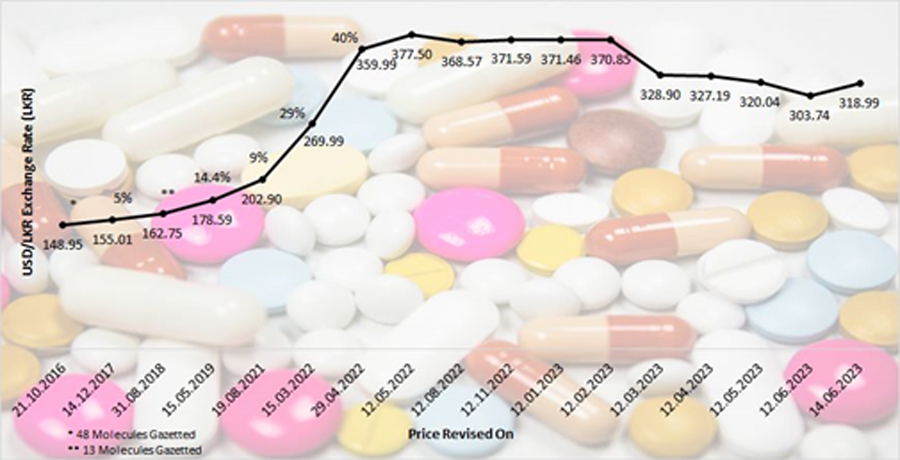There have been various misleading claims and misrepresentations made by various parties through both mainstream and social media on this subject.
While some of these unfortunately are the result of ill-informed positions others are clearly politically motivated with mala fide intentions.
Clearly an issue such as this needs attention but without bias and misinformation.
Therefore, we would like to provide the following clarifications in the wider interest of the general public.
1. Although it is being widely circulated that pharmaceuticals are governed by market forces and not price controlled, nothing can be further from the truth.
Pharmaceuticals have been and remains the most rigidly price-controlled commodity in the market.
2. 61 molecules are under gazetted price control where the maximum retail price is equivalent to the average price of all brands of the molecule.
Other than these 61 molecules, all others have their initial price determined by the National Medicines Regulatory Authority (NMRA) where the price in the country of origin as well as the regional prices are considered in determining the final price.
This price too is re-evaluated during the issuing of import licences every year and when registration is renewed every five years.
3. These 61 molecules cover more than 900 common generic/brands used to treat most chronic illnesses such as Diabetes, Heart Disease, Hypertension, and also most common Antibiotics.
4. The 61 products where strict Gazetted Price Control is applied, account for approximately 35% of the most commonly consumed medicines according to independent IQVIA data.
5. With the introduction of price control with effect from 2016 ‘market forces’ no longer apply to pharmaceutical pricing.
6. The government has allowed price increases of 5%, 14.4%, 9%, 29% and 40% respectively in order to counter the impact of the rapidly depreciating rupee.
It must be noted that the final increase granted was in April 2022 and that was to bring parity when the USD was trading at Rs. 352.
After that the dollar reached a peak of Rs. 372 and the pharmaceutical industry was not allowed to increase prices any further for a period of almost 10 months.
The dollar deprecation only started in January 2023.
7. The current value of the dollar justifies a price decrease of 10% - 13% in pharmaceuticals when all factors are taken into account.
This is the same price reduction the SLCPI proposed in writing to the Honourable Minister of Health.
However, any price decrease at the present time must be with a proviso for a price increase if there is an appreciation of the dollar.
In fact as per Central Bank data this has been happening in the last few days.
8. Any changes to the price of pharmaceuticals must factor in the expenses that are unique to the pharmaceutical industry such are cold chain maintenance, temperature controlling of warehouses, retail outlets and transportation.
Most of these are highly sensitive to the cost of fuel and finance cost.
9. Inordinate and haphazard delays in payments from the State Sector Agencies such as the SPC and MSD, have contributed to increased finance costs.
10. Although claims have been made that there have been 400% price increases in some pharmaceutical prices these remain unverified.
11. The pharmaceutical industry has only increased prices by what has been permitted which is on average less than that of all other widely consumed commodities in the market.
For the sake of brevity, the SLCPI has listed out only the independently verifiable facts regarding the pricing of pharmaceutical products as it stands today.
The Price revisions granted against the exchange fluctuations
In conclusion, we take this opportunity to outline the only possible solution which will ensure an uninterrupted and uniform supply of high-quality pharmaceuticals to the general public.
Sri Lanka is in need of a transparent, equitable and fair pricing mechanism that is applicable to all pharmaceuticals.
This has been an ongoing call to action by the SLCPI, and it has now been referred to the Court of Appeal of the country.
Such a mechanism cannot be formulated by the State alone but must involve all stakeholders and be consistent with the stipulations of National Medicinal Drugs Authority Act No 5 of 2015.
It would be ill advised and counterproductive in the long term for any one party, be it the government, the health care services, trade unions, religious leaders or even the pharmaceutical industry itself to be allowed to dictate the pricing of pharmaceuticals in a unilateral and /or random manner.
The implementation of a pricing mechanism is the only way to ensure the uninterrupted supply of high-quality pharmaceuticals at a fair and equitable price to the general public.






















